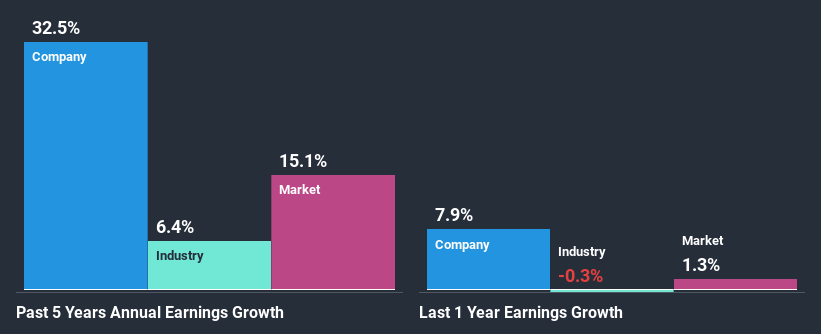Are Strong Financial Prospects The Force That Is Driving The Momentum In Bapcor Limited's ASX:BAP) Stock?

Bapcor (ASX:BAP) has had a great run on the share market with its stock up by a significant 22% over the last three months. Since the market usually pay for a company’s long-term fundamentals, we decided to study the company’s key performance indicators to see if they could be influencing the market. In this article, we decided to focus on Bapcor's ROE.
Return on Equity or ROE is a test of how effectively a company is growing its value and managing investors’ money. In simpler terms, it measures the profitability of a company in relation to shareholder's equity.
View our latest analysis for Bapcor
How Do You Calculate Return On Equity?
ROE can be calculated by using the formula:
Return on Equity = Net Profit (from continuing operations) ÷ Shareholders' Equity
So, based on the above formula, the ROE for Bapcor is:
13% = AU$96m ÷ AU$738m (Based on the trailing twelve months to December 2019).
The 'return' is the profit over the last twelve months. So, this means that for every A$1 of its shareholder's investments, the company generates a profit of A$0.13.
What Is The Relationship Between ROE And Earnings Growth?
So far, we've learned that ROE is a measure of a company's profitability. Depending on how much of these profits the company reinvests or "retains", and how effectively it does so, we are then able to assess a company’s earnings growth potential. Assuming everything else remains unchanged, the higher the ROE and profit retention, the higher the growth rate of a company compared to companies that don't necessarily bear these characteristics.
Bapcor's Earnings Growth And 13% ROE
To start with, Bapcor's ROE looks acceptable. Especially when compared to the industry average of 6.1% the company's ROE looks pretty impressive. This probably laid the ground for Bapcor's significant 33% net income growth seen over the past five years. However, there could also be other causes behind this growth. For instance, the company has a low payout ratio or is being managed efficiently.
We then compared Bapcor's net income growth with the industry and we're pleased to see that the company's growth figure is higher when compared with the industry which has a growth rate of 17% in the same period.
Earnings growth is an important metric to consider when valuing a stock. The investor should try to establish if the expected growth or decline in earnings, whichever the case may be, is priced in. By doing so, they will have an idea if the stock is headed into clear blue waters or if swampy waters await. If you're wondering about Bapcor's's valuation, check out this gauge of its price-to-earnings ratio, as compared to its industry.
Is Bapcor Efficiently Re-investing Its Profits?
Bapcor has a significant three-year median payout ratio of 51%, meaning the company only retains 49% of its income. This implies that the company has been able to achieve high earnings growth despite returning most of its profits to shareholders.
Moreover, Bapcor is determined to keep sharing its profits with shareholders which we infer from its long history of five years of paying a dividend. Upon studying the latest analysts' consensus data, we found that the company is expected to keep paying out approximately 49% of its profits over the next three years. Accordingly, forecasts suggest that Bapcor's future ROE will be 10% which is again, similar to the current ROE.
Summary
On the whole, we feel that Bapcor's performance has been quite good. Especially the high ROE, Which has contributed to the impressive growth seen in earnings. Despite the company reinvesting only a small portion of its profits, it still has managed to grow its earnings so that is appreciable. Having said that, the company's earnings growth is expected to slow down, as forecasted in the current analyst estimates. To know more about the latest analysts predictions for the company, check out this visualization of analyst forecasts for the company.
This article by Simply Wall St is general in nature. It does not constitute a recommendation to buy or sell any stock, and does not take account of your objectives, or your financial situation. We aim to bring you long-term focused analysis driven by fundamental data. Note that our analysis may not factor in the latest price-sensitive company announcements or qualitative material. Simply Wall St has no position in any stocks mentioned.
Have feedback on this article? Concerned about the content? Get in touch with us directly. Alternatively, email editorial-team@simplywallst.com.



